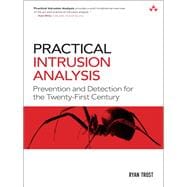
Note: Supplemental materials are not guaranteed with Rental or Used book purchases.
Purchase Benefits
What is included with this book?
Ryan Trost is the Director of Security and Data Privacy Officer at Comprehensive Health Services where he oversees all the organization’s security and privacy decisions. He teaches several Information Technology courses, including Ethical Hacking, Intrusion Detection, and Data Visualization at Northern Virginia Community College. This enables him to continue exploring his technical interests among the endless managerial meetings. In his spare time, Ryan works to cross-pollinate network security, GIS, and data visualization. He is considered a leading expert in geospatial intrusion detection techniques and has spoken at several conferences on the topic, most notably DEFCON 16. Ryan participated as a RedTeamer in the first annual Collegiate Cyber Defense Competition (CCDC) and now fields a team of students in the annual event. Ryan has been a senior security consultant for several government agencies before transitioning over to the private sector. In 2005, Ryan received his masters of science degree in computer science from George Washington University where he developed his first geospatial intrusion detection tool.
| Preface | p. xv |
| Network Overview | p. 1 |
| Infrastructure Monitoring | p. 31 |
| Intrusion Detection Systems | p. 53 |
| Lifecycle of a Vulnerability | p. 87 |
| Proactive Intrusion Prevention and Response via Attack Graphs | p. 119 |
| Network Flows and Anomaly Detection | p. 151 |
| Web Application Firewalls | p. 185 |
| Wireless IDS/IPS | p. 209 |
| Physical Intrusion Detection for IT | p. 235 |
| Geospatial Intrusion Detection | p. 275 |
| Visual Data Communications | p. 347 |
| Return on Investment: Business Justification | p. 391 |
| Appendix: Bro Installation Guide | p. 435 |
| Index | p. 441 |
| Table of Contents provided by Publisher. All Rights Reserved. |
The New copy of this book will include any supplemental materials advertised. Please check the title of the book to determine if it should include any access cards, study guides, lab manuals, CDs, etc.
The Used, Rental and eBook copies of this book are not guaranteed to include any supplemental materials. Typically, only the book itself is included. This is true even if the title states it includes any access cards, study guides, lab manuals, CDs, etc.